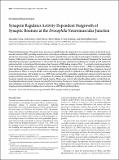Synapsin Regulates Activity-Dependent Outgrowth of Synaptic Boutons at the Drosophila Neuromuscular Junction
Author(s)
Vasin, Alexander; Zueva, Lidia; Torrez, Carol; Volfson, Dina; Littleton, J. Troy; Bykhovskaia, Maria; ... Show more Show less
DownloadVasin-2014-Synapsin Regulates A.pdf (4.464Mb)
PUBLISHER_POLICY
Publisher Policy
Article is made available in accordance with the publisher's policy and may be subject to US copyright law. Please refer to the publisher's site for terms of use.
Terms of use
Metadata
Show full item recordAbstract
Patterned depolarization of Drosophila motor neurons can rapidly induce the outgrowth of new synaptic boutons at the larval neuromuscular junction (NMJ), providing a model system to investigate mechanisms underlying acute structural plasticity. Correlative light and electron microscopy analysis revealed that new boutons typically form near the edge of postsynaptic reticulums of presynaptic boutons. Unlike mature boutons, new varicosities have synaptic vesicles which are distributed uniformly throughout the bouton and undeveloped postsynaptic specializations. To characterize the presynaptic mechanisms mediating new synaptic growth induced by patterned activity, we investigated the formation of new boutons in NMJs lacking synapsin [Syn(−)], a synaptic protein important for vesicle clustering, neurodevelopment, and plasticity. We found that budding of new boutons at Syn(−) NMJs was significantly diminished, and that new boutons in Syn(−) preparations were smaller and had reduced synaptic vesicle density. Since synapsin is a target of protein kinase A (PKA), we assayed whether activity-dependent synaptic growth is regulated via a cAMP/PKA/synapsin pathway. We pretreated preparations with forskolin to raise cAMP levels and found this manipulation significantly enhanced activity-dependent synaptic growth in control but not Syn(−) preparations. To examine the trafficking of synapsin during synaptic growth, we generated transgenic animals expressing fluorescently tagged synapsin. Fluorescence recovery after photobleaching analysis revealed that patterned depolarization promoted synapsin movement between boutons. During new synaptic bouton formation, synapsin redistributed upon stimulation toward the sites of varicosity outgrowth. These findings support a model whereby synapsin accumulates at sites of synaptic growth and facilitates budding of new boutons via a cAMP/PKA-dependent pathway.
Date issued
2014-08Department
Massachusetts Institute of Technology. Department of Biology; Picower Institute for Learning and MemoryJournal
Journal of Neuroscience
Publisher
Society for Neuroscience
Citation
Vasin, A., L. Zueva, C. Torrez, D. Volfson, J. T. Littleton, and M. Bykhovskaia. “Synapsin Regulates Activity-Dependent Outgrowth of Synaptic Boutons at the Drosophila Neuromuscular Junction.” Journal of Neuroscience 34, no. 32 (August 6, 2014): 10554–10563.
Version: Final published version
ISSN
0270-6474
1529-2401